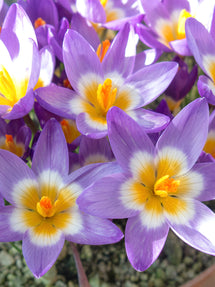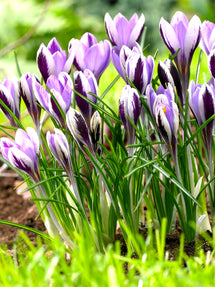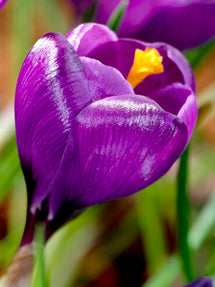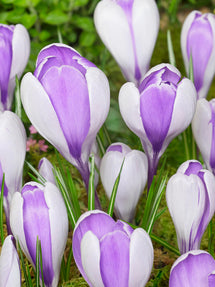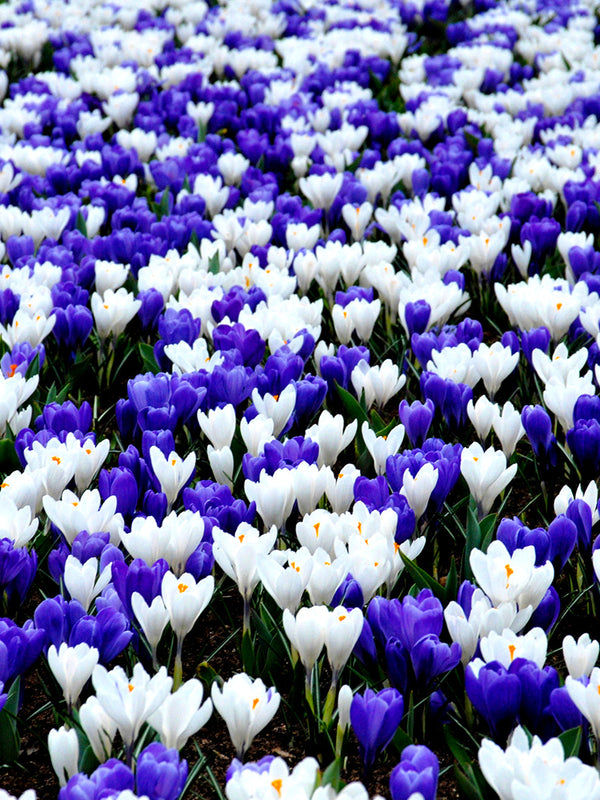Crocus
Crocus: A True Testament To The Beauty Of Your Spring Garden
There’s something truly magical about spring-blooming Crocus. As the long winter begins to loosen its grip, these low-growing plants are one of the first flowers that emerge from the frozen ground and snow, bringing vibrant bursts of yellow, white, blue, and purple flowers. Whether you're a seasoned gardener or just starting, these cup-shaped flowers add a distinctive charm to any UK garden, from flower beds to containers. Discover our collection of top-sized Crocus bulbs, carefully selected for their exceptional strength, vibrant colour, and reliable bloom.
Showing 1 - 6 in 6 items
What Makes The Crocus Flower Special? More Than Just A Pretty Face
The Crocus is one of the earliest and most rewarding flowers you can plant. These hardy perennials belong to the Iris family and include around 90 species, all of which grow from corms. Emerging through the late winter snow, they display bright, goblet-shaped blooms and slender, grass-like leaves that instantly lift the spirit of any garden. Their easy nature makes them a firm favourite among both novice and experienced gardeners. Crocuses also pair beautifully with taller spring-flowering bulbs such as early Tulips and Daffodils.
However, Crocuses offer far more than just colourful blooms. These early bloomers serve as a vital lifeline for bees and other pollinators at a time when few other plants are in bloom. They naturalise effortlessly in lawns, multiply freely, and add a welcome splash of colour to winter gardens. Better still, they are rarely troubled by deer, rabbits, or squirrels. With their winning combination of resilience and charm, Crocus bulbs bring far more to your garden than meets the eye.
A Dozen Crocus Varieties: From Purple To White Crocuses
Crocus flowers may be modest in size, but their variety is truly remarkable. Native to the Alps and the Mediterranean, these resilient blooms have adapted beautifully to gardens and landscapes worldwide, including your own. At DutchGrown, we offer a diverse range of premium Crocus bulbs to suit every gardener’s taste and growing conditions. Discover 4 spring-flowering types:
- Crocus ‘Sieberi Tricolor’: A charming variety that produces six-petalled, lilac-blue blooms, with a bold white band encircling a vivid golden-yellow centre.
- Crocus ‘Pickwick’: This early Crocus showcases striking, striped petals in brilliant white and cool violet-blue, set off by warm golden anthers at the heart of each bloom.
- Crocus ‘Striped Bird’: This variety features soft lavender petals streaked with creamy white, creating a captivating, almost painterly display.
- Crocus ‘Orange Monarch’: A rare and exciting addition, the ‘Orange Monarch’ stuns with bold orange petals adorned with rich purple to brown flames.
Crocus Mixes And Saffron Crocus
If you're uncertain about which Crocuses to choose, our expertly curated mixes offer a stunning combination of varieties, creating a vibrant and natural display. Looking for autumn Crocuses? The Saffron Crocus (Crocus Sativus or True Saffron Crocus) is a true highlight, blooming in the autumn and offering not only visual beauty but also a nod to a rich culinary tradition.
Planting Crocus Bulbs In The UK For Maximum Effect In Your Garden
Planting Crocus bulbs is straightforward, but following a few essential steps can greatly enhance their flowering potential. For best results, plant them in autumn before the ground begins to freeze, ensuring the soil temperature is around 15°C or lower.
Begin by selecting a location that receives full sun or partial shade, with well-drained soil. Dig holes approximately 5–7 cm deep, spacing each bulb about 7 cm apart. If you're planting in pots, you may place the bulbs closer together in small groups to achieve a more abundant display. Position each bulb with the pointed tip facing upwards. Once in place, cover them with soil and water thoroughly to help the earth settle around the bulbs. Fertiliser is not required. During the growing season, monitor rainfall. If there has been no rain for 3 to 5 days, provide a light watering to keep the soil slightly moist.
Crocus flowers bloom in late winter or early spring, depending on the conditions. After blooming, allow the foliage to die back naturally. With just a little care and patience, you’ll be rewarded with vibrant early-season colour, year after year. Need more guidance? Simply follow the steps in our growing guide, ‘How to Grow Crocus Bulbs?’.
Top-quality Crocus Bulbs For Sale At DutchGrown
Are you ready to transform your garden with glorious spring bloomers? Whether you’re planting a few in containers or designing a naturalised display, Crocus bulbs from DutchGrown provide reliable and impressive results. Our range features both exceptional individual varieties and expertly curated collections, each selected for maximum visual impact. Explore our Crocus collection and begin planning your most beautiful spring yet. We deliver throughout the United Kingdom.
Frequently Asked Questions About Crocuses
Does Crocus Come Back Every Year?
Crocus plants are perennial plants, meaning they return year after year. With the right care and favourable conditions, Crocus bulbs (technically corms) can bloom reliably each spring for up to five years.
What Is The Best Month To Plant Crocus Bulbs?
The ideal time to plant Crocus bulbs in the UK is during the early and late autumn months, typically between September and November. Aim to plant them once soil temperatures have fallen to around 15°C, but before the ground begins to freeze. This timing allows the bulbs to establish strong root systems ahead of winter, setting the stage for a vibrant display of blooms in early spring.
What Do You Do With Crocus Bulbs After They Bloom?
After flowering, Crocuses go dormant. It’s important to allow the foliage to remain undisturbed, as it continues to photosynthesise and store energy in the bulb for the following year. Once the leaves have turned yellow and withered naturally, they can be gently removed. The bulbs may be left in the ground; however, if the soil is poorly drained, there is a risk of rot.
Do Crocus Bulbs Multiply?
There’s a good chance that Crocus bulbs will multiply every year. As perennials, they return each spring, and under the right conditions, they readily naturalise in sunny spots or partial shade locations. This means they’ll gradually form larger clusters in the next season, creating an increasingly vibrant and beautiful display with minimal effort.
When Does A Crocus Flower?
The flowering season for Crocuses varies depending on the species. Most varieties bloom in early spring—or even late winter—when few other plants are in flower. A notable exception is the Saffron Crocus (Crocus Sativus), which produces its delicate blooms in the autumn.
